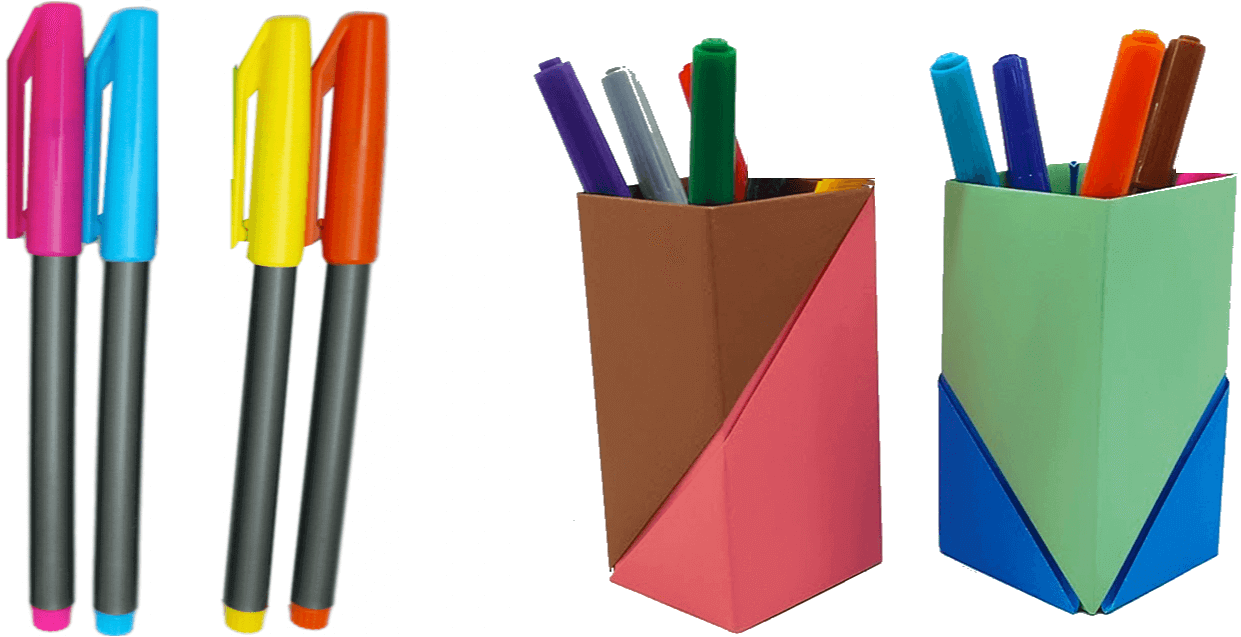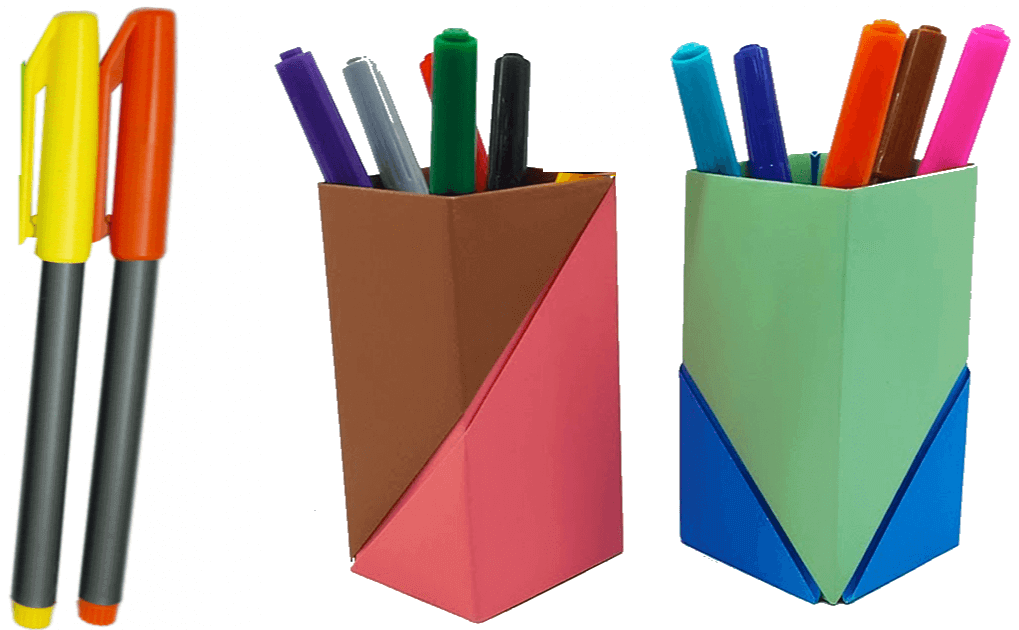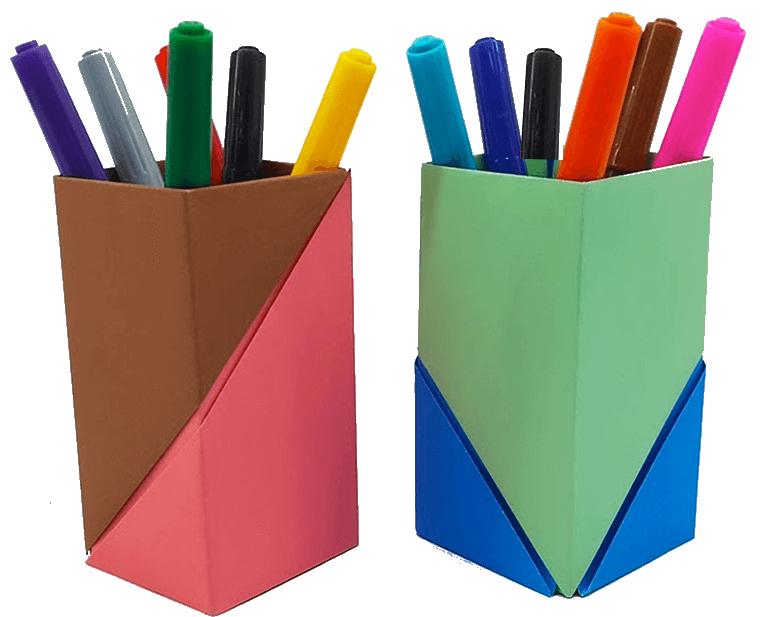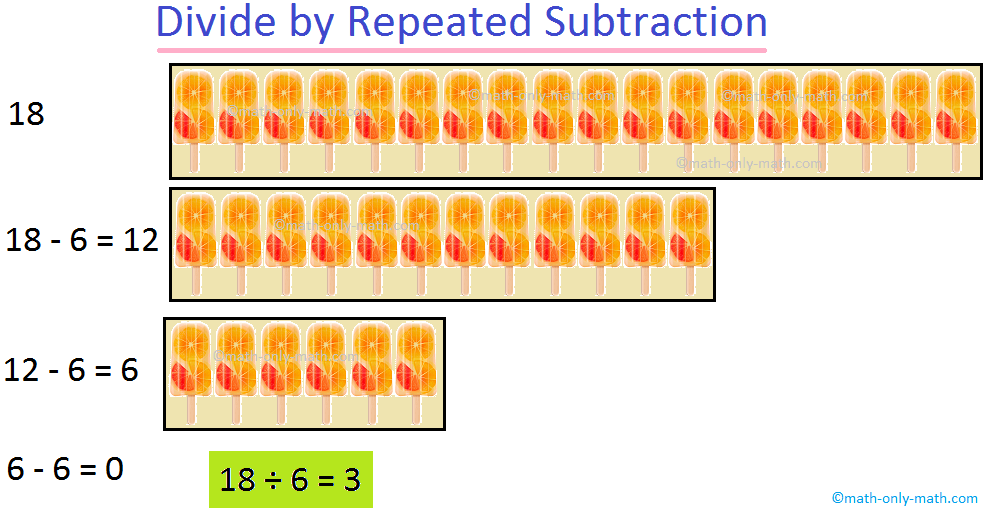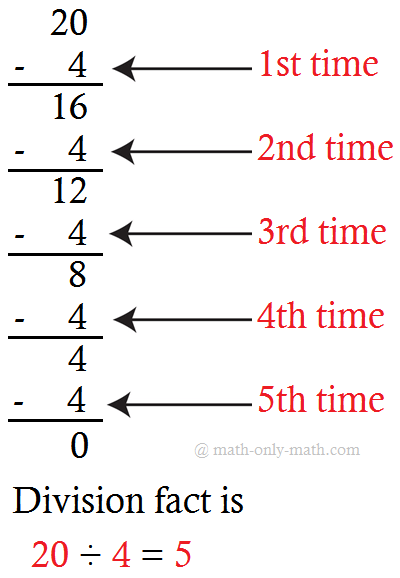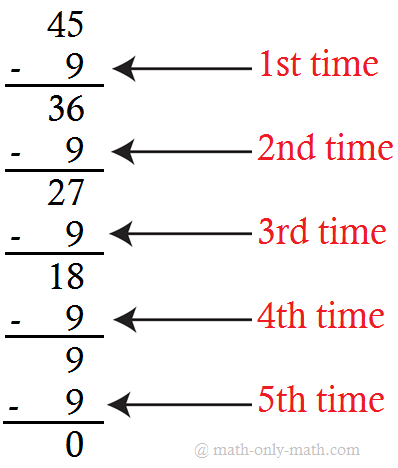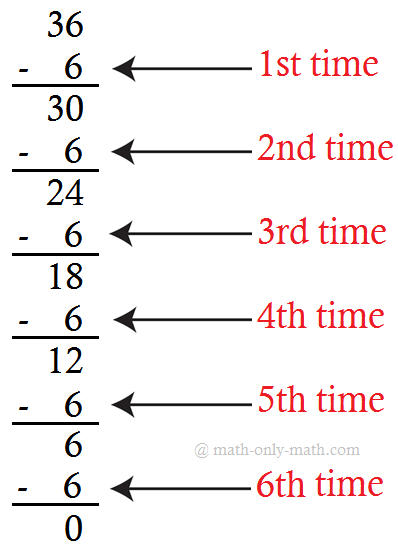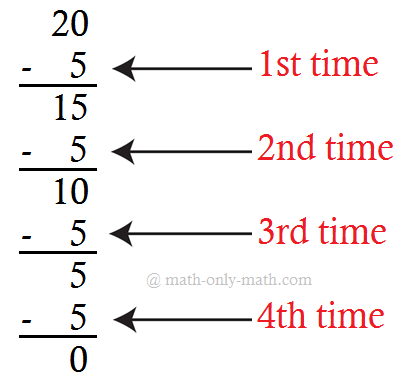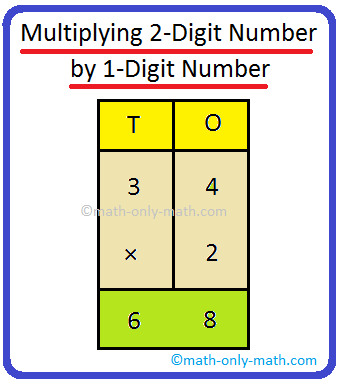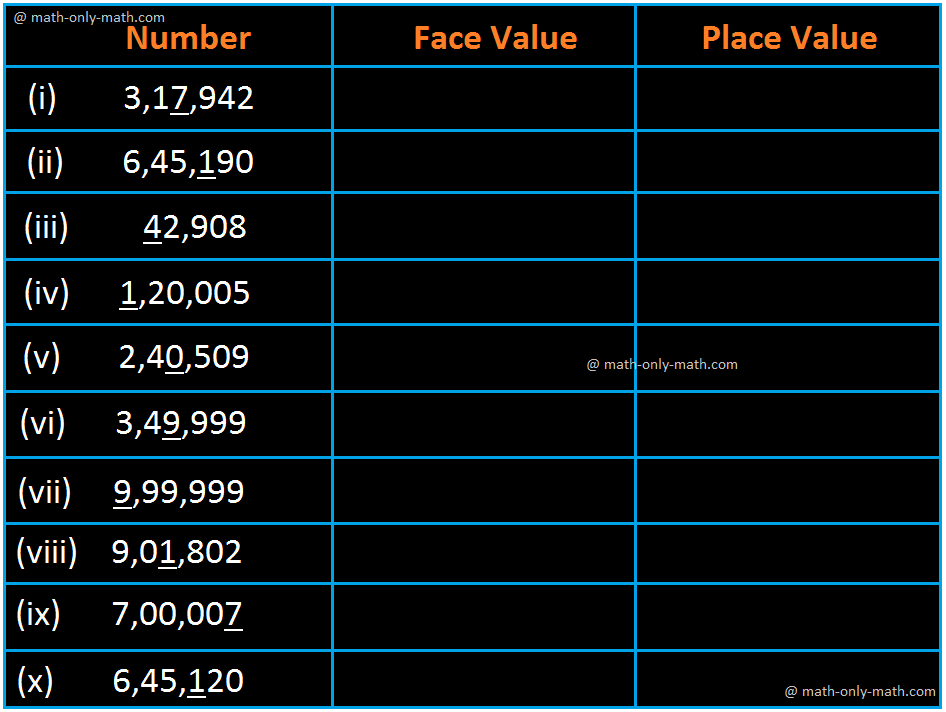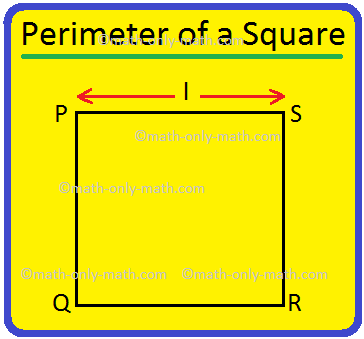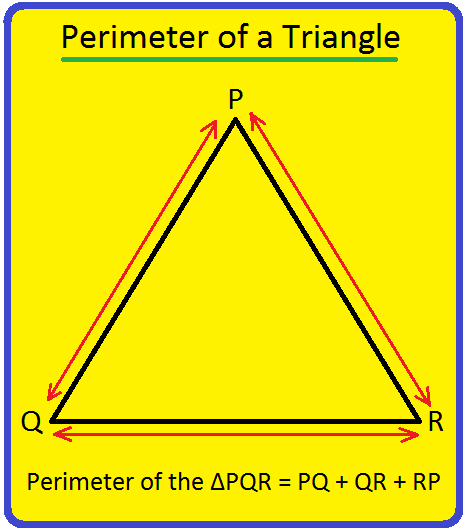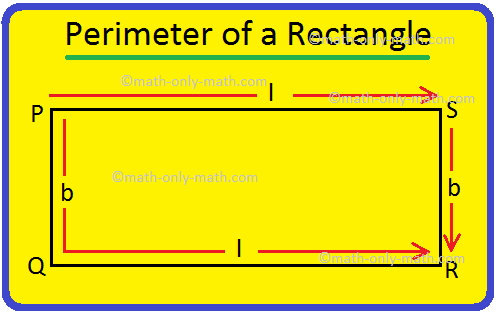Divide by Repeated Subtraction
How to divide by repeated subtraction?
We will learn how to find the quotient and remainder by the method of repeated subtraction a division problem may be solved.
DIVISION AS REPEATED SUBTRACTION
As multiplication is repeated addition, division is repeated subtraction.
Let us see how.
We know that division is equal distribution of objects.
When we divide, we find out how many times we can subtract the given number from the group of objects.
Let us understand this with the help of following examples.
1. 12 pens have to be equally kept in 2 penstands.
So, how many times can 2 be taken away from 12?
Let us subtract 2 again and again from 12 till we reach 0.
How many times 2 has been subtracted from 12 to reach 0? Clearly, 6
Therefore, 12 ÷ 2=6
Solved examples on divide by repeated subtraction:
1. Solve 16 ÷ 8
Solution:
8 is subtracted repeatedly from 16 as shown:
When 8 is subtracted from 16, 2 times, then we get the remainder zero.
Hence, 16 ÷ 8 = 2, 2 is the quotient.
2. Divide 20 ÷ 5
5 is subtracted repeatedly from 20 as shown:
When 5 is
subtracted from 20, four times, then we get the remainder zero.
Hence, 20 ÷ 5 = 4, 4 is the quotient.
3. Solve 12 by 3
Solution:
3 is subtracted repeatedly from 12 as shown:
When 3 is
subtracted from 12, four times, then we get the remainder zero.
Hence, 12 ÷ 3 = 4, 4 is the quotient.
4. Divide 28 ÷ 7
7 is subtracted repeatedly from 28 as shown:
When 7 is
subtracted from 28, four times, then we get the remainder zero.
Hence, 28 ÷ 7 = 4, 4 is the quotient.
5. Divide 32 ÷ 4
4 is subtracted repeatedly from 32 as shown:
When 4 is
subtracted from 32, eight times, then we get the remainder zero.
Hence, 32 ÷ 4 = 8, 8 is the quotient.
6. Solve 18 by 6.
6 is subtracted repeatedly from 18 as shown:
When 6 is subtracted from 18, three times, then we get the remainder zero.
Hence, 18 ÷ 6 = 3, 3 is the quotient.
7. Divide 12 flowers in 3 vases.
We put 1 flower in each of the 3 vases and subtract 3 from 12 each time.
12 – 3 = 9
9 – 3 = 6
6 – 3 = 3
3 – 3 = 0
There are no more flowers left. We subtracted 4 times 3 from 12.
We subtract 3 flowers 4 times from 12 to get 0.
7. Divide 18 ice creams among 6 children by repeated subtraction.
8. Find 12 ÷ 4 by repeated subtraction.
Example:
12 - 4 = 8 → 8 - 4 = 4 → 4 - 4 = 0
4 can be subtracted 3 times from 12. So, 12 ÷ 4 = 3
The above examples will help us to solve various division problems on 2-digit number by a single digit number using the method of repeated subtraction.
Division by Equal Distribution:
When 8 balls are equally distributed in 2 boys, we write 8 ÷ 2 = 4
Questions and Answers on Divide by Repeated Subtraction:
1. Divide using repeated subtraction. One has been done for you.
(i) Divide 16 by 4.
|
T O 1 6 - 4 1 2 |
T O 1 2 - 4 8 |
T O 8 - 4 4 |
T O 4 - 4 0 |
16 ÷ 4 = 4 |
(ii) Divide 6 by 2.
|
T O 6 - 2
|
T O
|
T O
|
T O
|
6 ÷ 2 = __ |
(iii) Divide 12 by 3.
|
T O 1 2 - 3
|
T O
|
T O
|
T O
|
12 ÷ 3 = __ |
(iv) Divide 20 by 5.
|
T O 2 0 - 5
|
T O
|
T O
|
T O
|
20 ÷ 5 = __ |
(v) Divide 14 by 7.
|
T O 1 4 - 7
|
T O
|
T O
|
T O
|
14 ÷ 7 = __ |
Answer:
1. (ii)
|
T O 6 - 2 4 |
T O 4 - 2 2 |
T O 2 - 2 0 |
|
6 ÷ 2 = 3 |
(ii)
|
T O 1 2 - 3 9 |
T O 9 - 3 6 |
T O 6 - 3 3 |
T O 3 - 3 0 |
12 ÷ 3 = 4 |
(iii)
|
T O 2 0 - 5 1 5 |
T O 1 5 - 5 1 0 |
T O 1 0 - 5 5 |
T O 5 - 5 0 |
20 ÷ 5 = 4 |
(iv)
|
T O 1 4 - 7 7 |
T O 7 - 7 0 |
|
|
14 ÷ 7 = 2 |
2. Write the following subtractions as division facts. One has been done for you.
(i)
3. Write the following division facts as repeated subtractions. One has been done for you.
(i) 20 ÷ 5 = 4
Repeated subtraction for the given fact is:
|
(ii) |
35 ÷ 7 = 5 Repeated subtraction for the given fact is: |
(iii) |
48 ÷ 6 = 8 Repeated subtraction for the given fact is: |
From Divide by Repeated Subtraction to HOME PAGE
Didn't find what you were looking for? Or want to know more information about Math Only Math. Use this Google Search to find what you need.
Recent Articles
-
Perimeter of a Square | How to Find the Perimeter of Square? |Examples
Apr 25, 24 05:34 PM
We will discuss here how to find the perimeter of a square. Perimeter of a square is the total length (distance) of the boundary of a square. We know that all the sides of a square are equal. Perimete… -
Perimeter of a Triangle | Perimeter of a Triangle Formula | Examples
Apr 25, 24 05:13 PM
We will discuss here how to find the perimeter of a triangle. We know perimeter of a triangle is the total length (distance) of the boundary of a triangle. Perimeter of a triangle is the sum of length… -
Perimeter of a Rectangle | How to Find the Perimeter of a Rectangle?
Apr 25, 24 03:45 PM
We will discuss here how to find the perimeter of a rectangle. We know perimeter of a rectangle is the total length (distance) of the boundary of a rectangle. ABCD is a rectangle. We know that the opp… -
Dividing 3-Digit by 1-Digit Number | Long Division |Worksheet Answer
Apr 24, 24 03:46 PM
Dividing 3-Digit by 1-Digit Numbers are discussed here step-by-step. How to divide 3-digit numbers by single-digit numbers? Let us follow the examples to learn to divide 3-digit number by one-digit nu… -
Symmetrical Shapes | One, Two, Three, Four & Many-line Symmetry
Apr 24, 24 03:45 PM
Symmetrical shapes are discussed here in this topic. Any object or shape which can be cut in two equal halves in such a way that both the parts are exactly the same is called symmetrical. The line whi…




